Page 2 of 8
Re: August 2011
Posted: Thu Aug 04, 2011 10:50 am
by MikeOxon
I only looked briefly at your photo and may have jumped to conclusions too quickly. I'm sure Piers is much more experienced than I am. I think we are all agreed that it is some from of 6-spot and that this is not an illicit affair!
Mike
Re: August 2011
Posted: Thu Aug 04, 2011 11:14 am
by Gibster
Agreed that the burnet is a worn individual rather than
flava, but it definitely only has 5 spots. Um..?

Guess we could all troll up to the site next year and add '5.5 spot Burnet' to our lists, lol

Re: August 2011
Posted: Thu Aug 04, 2011 11:52 am
by MikeOxon
I think there is a 6th spot,though it is rather obscured. Always nice to have a good excuse to visit somewhere new, though.
Mike
Re: August 2011
Posted: Thu Aug 04, 2011 12:00 pm
by Perseus
MikeOxon wrote:I think there is a 6th spot,though it is rather obscured. Always nice to have a good excuse to visit somewhere new, though.
Mike
The sixth spot regularly fades.
Re: August 2011
Posted: Thu Aug 04, 2011 12:53 pm
by Dave McCormick
Piers wrote:I disagree with Mike,
flava is very yellow, and when you see it there is no mistake. It could be just an aged specimen, they do become very pale, almost translucent. The hind wings also appear to be red,
flava has no trace of red at all.
Having said that, it's very difficult from a photograph, so Mike d'Oxen could well be correct.

Piers.
I have seen flava once,and yes the spots are very yellow. This one appears to be a faded red (a worn flava wouldn't be, still be yellowish), so its just a worn normal adult to me.
Re: August 2011
Posted: Fri Aug 05, 2011 1:18 pm
by David M
I'm in the back garden of my closest friend's guest house in Abergavenny at the moment and on the buddleia there is.....
....a Painted Lady (only my 5th of the year)!
Re: August 2011
Posted: Fri Aug 05, 2011 2:55 pm
by Mark Senior
Castle Hill NR Woodingdean Brighton . 11 am till 1 pm today .
No hoped for Silver Spotted Skippers and disappointingly no Adonis Blues but plenty to see .
Meadow Brown circa 100
Chalkhill Blue circa 50
Common Blue circa 30 ( a very low number considering the vast areas of Birds Foot Trefoil , the Common Blue is having a bad year in Sussex )
Gatekeeper circa 20
Marbled White circa 15 ( some still very fresh looking )
Small Heath circa 15
2nd brood Dingy Skipper 5
Small/Essex Skipper circa 10
Large Skipper circa 5 ( thought they would have been over by now )
Dark Green Fritillary 4 ( all Female 1 very fresh condition )
Speckled Wood x 3
Small Copper 3
Brown Argus 1
Red Admiral 1
Large and Small Whites
Re: August 2011
Posted: Fri Aug 05, 2011 6:41 pm
by Dave McCormick
Yesterday I was out doing some work in a ancient bluebell wood (Oak, ash, Elm, Beech, Lime) by surveying the trees and plants in it and while on the edge at a hay meadow, I saw 2 large whites, 1 small white, 1 green-veined white, a worn meadow brown and hurray, a speckled wood! (not that enthralling I know, but I have only seen a few this year)
Re: August 2011
Posted: Fri Aug 05, 2011 7:56 pm
by millerd
Wednesday early afternoon (3rd), I had a stroll around the area of my patch between the River Colne and the M25, just north of J14. The area has patches of wild flowers, but the soil is so poor vast tracts only support a kind of white clover, which nevertheless covers the ground in a carpet. Even this was drying out (again) and looking sad. However, I know that the local Common Blues, in the absence of much BFT, use it as a foodplant. Having seen very few of them so far in the second brood, the numbers had now rocketed, and I lost count in the 30s. There were a good number of females, though they were only really found when the males gave them away, and neither sex was prepared to open their wings in the hot sunshine (nearly 30 degrees at nearby Heathrow). I did however find a mating pair. The Small Heath colony continued as it has without a break since early May, with dozens of individuals, rising in groups at almost every footstep. Mixed in with these were numerous Gatekeepers, and a fresh emergence of new-looking male Meadow Browns, and the odd Speckled Wood straying from the woodland margin. I also watched a Holly Blue tumble down from the upper reaches of a largish Hawthorn and confuse itself with the Common Blues for a while before regaining its composure and adjourning to the hedge. I had seen a few Brown Argus here a couple of days earlier, but none today, and the larger Nymphalids were all absent despite good quality thistle, burdock and teazel.
All in all, not much variety, but made up for in sheer numbers. This has to be the best spot I have been to for Small Heath.
Dave
Re: August 2011
Posted: Sat Aug 06, 2011 10:31 am
by NickB
Some nice stuff, guys. Made a mad early-morning dash yesterday to the Wiltshire/Hants border with Phil to find my first Brown Hairstreak

He was sitting in the early sun, down in the grass on the edge of a field, under a line of ash. He had obviously survived the previous day's soaking, and was looking a little damp and worn. He flew up onto some brambles and opened his wings. Later we found a very chilled individual who, by the time we left, had spent at least 2+ hours down on the same burdock plant, and whom we introduced to a fellow Aurelian we meet later that afternoon.
A few other odd sighting of individuals or pairs of males up in the trees too, but none came close enough to photograph. Lots of very active Common Blue, Brown Argus, Holly Blue, Meadow Brown, Speckled Wood, Gatekeeper and several Small Heath, Large, Small and Green-veined White plus a few Small Copper, Red Admiral, a couple of Peacock and several Brimstone, including a few pristine females....
Phil did manage to avoid most of the carnage on the M25, A1, M1 and A14 on the way home - listening to the traffic news it seemed the whole world had gone mad and accidents were blocking nearly every motorway and carriageway on our route home - only an hour or so extra on the journey back. We were lucky; watching the queues on the other side of the M25, we felt sorry indeed for those who were heading for their holidays via Gatwick....

N
Re: August 2011
Posted: Sun Aug 07, 2011 11:49 am
by Michaeljf
Saturday 6th August – Aston Rowant, Oxfordshire
The weather continued to play havoc with any sort of planning for the weekend – originally we had planned to go to Cumbria (scrapped due to the wet & dull weather coming in). Juggling between BBC and Skys’ weather forecast, we decided (about 6am Saturday!) to plump for Aston Rowant (Chilterns, Oxfordshire) as at least there was likelihood of some sun and no big drenchings there

. We eventually arrived at Aston Rowant about 9:30 to some weak sunshine – and not entirely sure which reserve we should head to, we seemed to remember that other mailers had gone for the English Nature reserve, North of the M40 road. We took the lower walking path from the car-park – a nice walk through a little wooded area with plenty of willow-herbs and a range of deciduous trees and small shrubs

.
The lower edge of the reserve was pleasant if non-descript: a nice range of Marjoram flowers at the lower point of the reserve and a steep-ish hill with plenty of small wildflowers including bellflowers and lady’s bedstraw. There was a low belt of clouds over us and within half an hour or so the weak sun disappeared. There were, however, still plenty of Chalkhill Blues, Small Heaths, Brown Argus and Silver-Spotted Skippers to be seen: one of the benefits of these species even in poor conditions (and these Skippers were a first for me). There were several Red Kites above us that stayed for most of the morning, hovering to and fro in the freshening breeze. I kept on thinking that the sun would re-emerge, but every half an hour when it looked like it would, the rain would start again (though not always heavy)

. I hardly noticed I was getting wet, happily walking about in a sleeveless shirt trying to photograph the Chalkhill Blues on Marjoram

.
About 1pm we left for a break and checked out Bernwood Meadows for Brown Hairstreaks. As we stopped on the way at the motorway services the rain finally gave everyone a good drenching for about 20 minutes, and then the sun came out as we got to Bernwood. Unfortunately the wind arrived again and there was no sign of any Hairstreaks there, though there was a range of butterfly enthusiasts walking the field that would be disappointed today

.
About 3pm we returned to Aston Rowant. Again the cloud was low and ominous, but within another hour there was a sun break and on the higher slopes I would finally see the Silver-Spotted Skippers in their proper numbers: there were probably about 30-40 individuals, now they could be seen in batches or three or four, looking for mates (or maybe just boisterous)

. We stayed until just after 5:30 when the cloud had returned - as per most of the day - but the temperatures were still quite good (the sun returned on our journey home). I think we’d made the best of a poor day’s weather...Aston Rowant is a nice spot, only spoilt by the constant noise of the motorway traffic (you soon forget about it if the butterflies are out) and it is a great spot for the Blues and the Skippers at this time of the year, though your biggest problem may be avoiding the many piles of sheep pooh along the higher slopes...

Michael
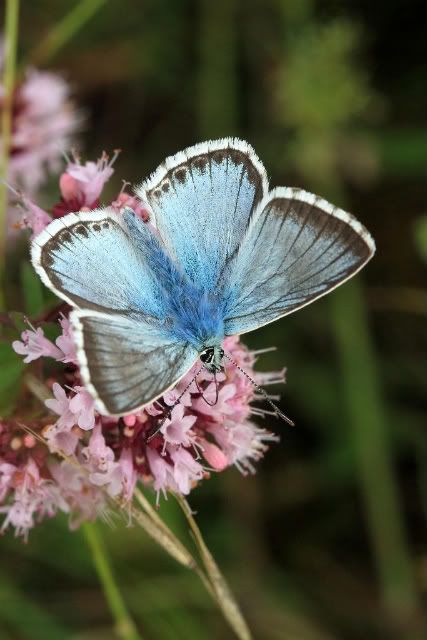
One of the lovely Chalkhill Blues makes the most of the Marjoram, even in dull weather.
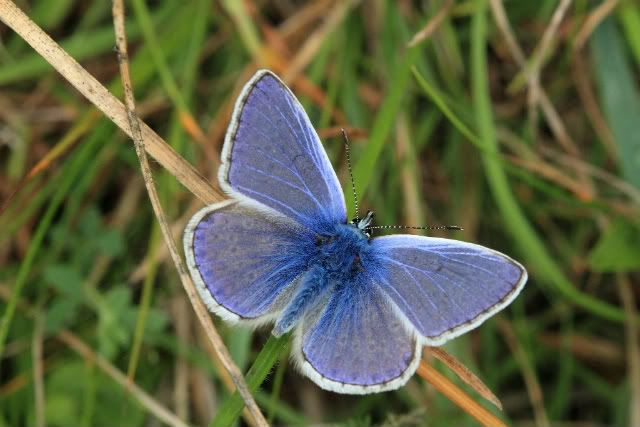
There were also a few fresh 2nd brood Common Blues amongst the many Chalkhills.
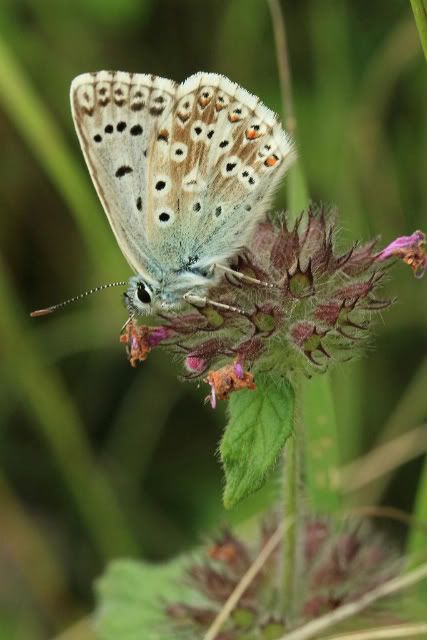
As the weather clouded over midday, the Blues took to resting. Good idea...
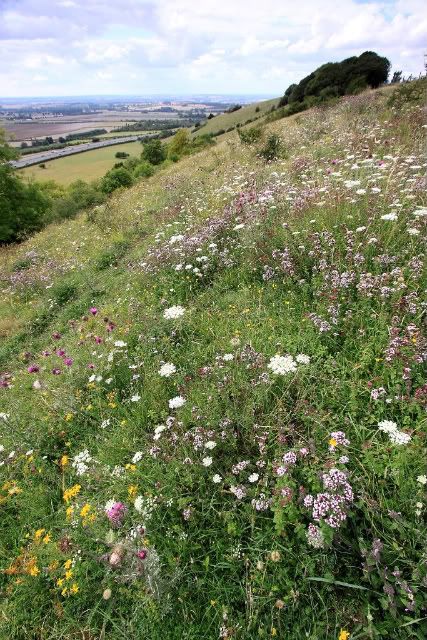
Returning to Aston Rowant in the mid-afternoon, the sun finally decided to come out for about an hour.
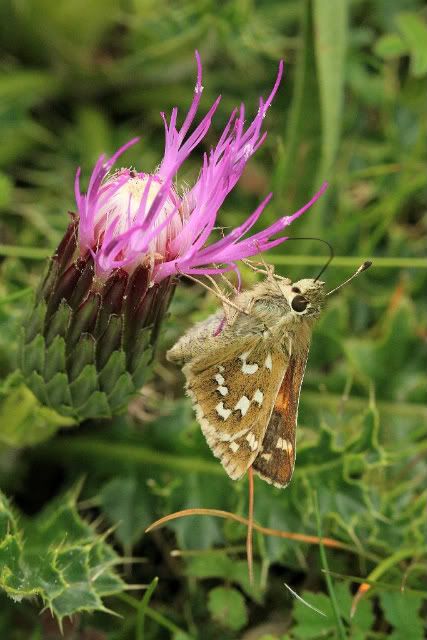
The Silver-Spotted Skippers were now a lot faster in better conditions.
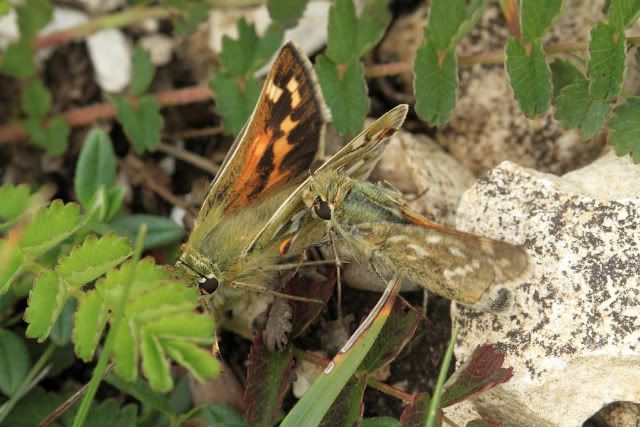
There was a lot of mating behavour going on.
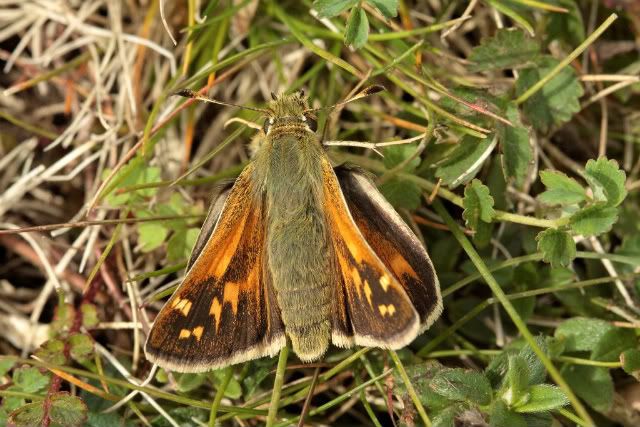
A few individuals would stop to gain the best of the sun. When I got up I found I had trodden in the sheep pooh. Yuch!
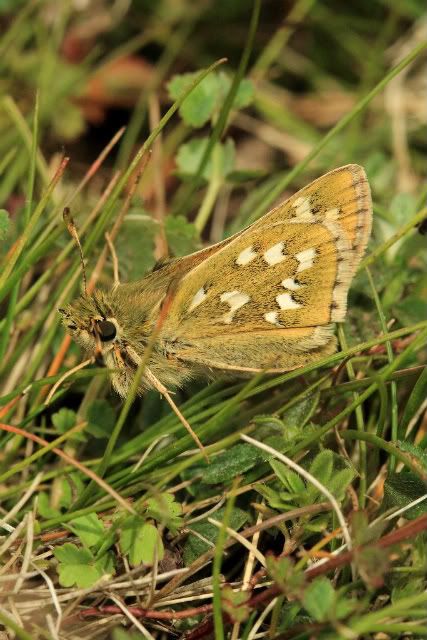
These Skippers are beautiful little Butterflies, though a bit difficult to get their true colours in the sunlight.
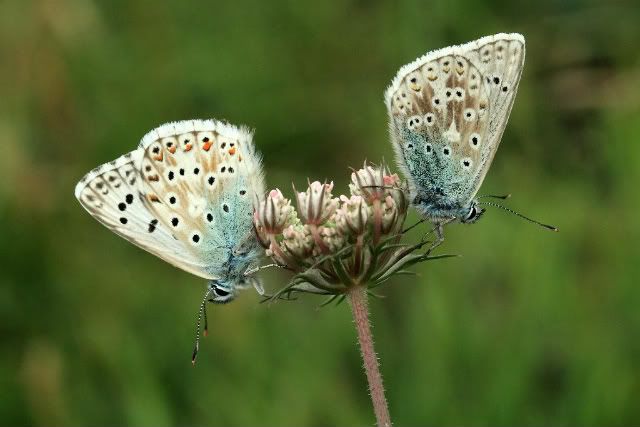
They're not even talking to each other anymore...
Re: August 2011
Posted: Sun Aug 07, 2011 3:30 pm
by Willrow
That's a fine report Michael and those photo's are'nt half bad either

You seem to have had quite an assortment of British summertime weather, but you saw your target species, and in particular
Silver-spotted Skipper which is something I failed to do on Fontmell Down in Dorset on Friday

still we can't get it right everytime we go out butterflying can we and if we could it would be boring

Thanks for sharing
Bill

PS. I've just noticed this is my 100th post...HIP HIP...
Re: August 2011
Posted: Sun Aug 07, 2011 5:02 pm
by Michaeljf
Hi Bill,
Thanks for the compliment on the photos - I merely did the best I could under the circumstances...strangely enough, while I was 'weighing up' where to go on Friday night, Fontmell Down was one of the places I was thinking of going and I only changed my mind at the last minute. The weather must have been quite good on Friday and I'm surprised you didn't see the Silver-Spotted Skipper there. As you say, wouldn't it be boring to see everything we wanted to when we planned

I'd really hate for that to happen



Regarding unpredictability, I returned to Penallta Parc this afternoon and after the early afternoon showers, the weather was great for landscape shots but the wind scuppered any chance of good Grayling shots!
Michael
Re: August 2011
Posted: Sun Aug 07, 2011 7:57 pm
by NickB
Spent a quiet day with the Common Blue and my wide-angle macro in the cemetery...

....found half-dozen males and at least 3 females....

- Heavily-marked female - with blue upperside...still trying for that shot!
N
Re: August 2011
Posted: Sun Aug 07, 2011 11:01 pm
by RobS
Common Blues are such a beautiful butterfly and are deserving of a more exotic name.they seemed to be in good numbers up on noar hill reserve on friday along with a couple of brown argus,lots of gatekeepers,silver washed frits,red admirals,peacocks,small copper,meadow brown and a solitary marbled white, who lured me into a bramble before flying off laughing.
no BH unfortunately this time.ive yet to see one,but in the process of looking i met a few other butterfly hunters/naturalists and they shared some of their vast knowledge with me.Although i dipped on the BH it was far from a wasted day with the brown argus and the common blue being firsts for me in the month ive been searching for new species.27 down...wish it had been 28 !!
rob
Re: August 2011
Posted: Mon Aug 08, 2011 9:35 am
by MikeOxon
Michaeljf wrote:Returning to Aston Rowant in the mid-afternoon, the sun finally decided to come out for about an hour.
I think that is a splendid photo of the slope at Aston Rowant - you've really caught the 'feel' ofthe place. Your photo has also made the M40 look further away - I wish it was in reality!
Mike
Re: August 2011
Posted: Mon Aug 08, 2011 11:37 am
by Michaeljf
MikeOxon wrote:Your photo has also made the M40 look further away - I wish it was in reality! Mike
Hi Mike,
thanks for the compliment - and yes, without the M40 the site would be even better, though I admit once the sun came out and I was lying down on one of the paths, trying to get a good photo of the Skippers, I really forgot about the noise very quickly!
n.b. And I can always tell when I've been looking for Blues as I normally find several ant bites on me the next day..

Michael
Re: August 2011
Posted: Mon Aug 08, 2011 8:00 pm
by David M
Had a weekend off butterflying in Abergavenny, but throughout the three days I was there, a Painted Lady barely left the garden. It looked like a female judging by the abdomen and seemed perfectly content to remain in situ, although laps of the rather large back yard were irresistible.
She liked surveying things from the roof:
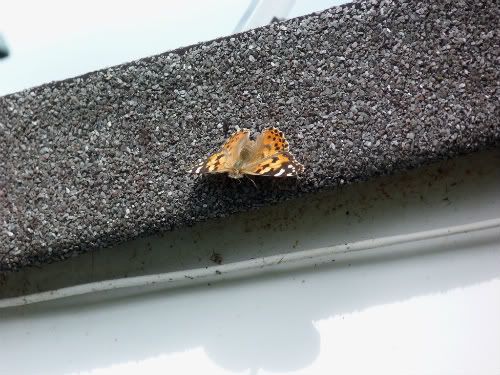
Foliage was a regular basking spot:
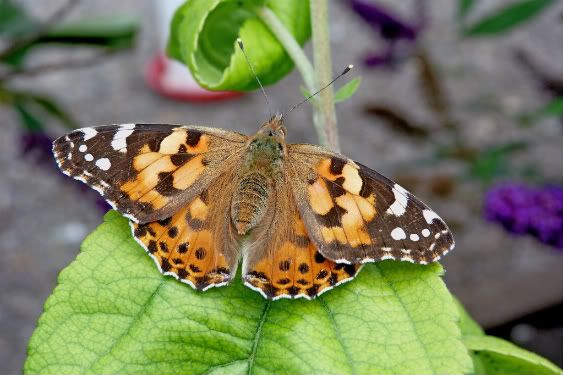
Of course, the buddleia was a frequent attraction:
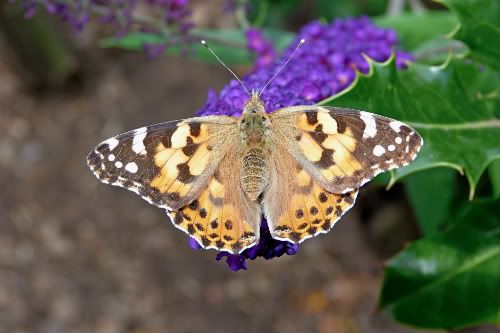
And she also did a fine job avoiding the many greedy beaks at ground level:
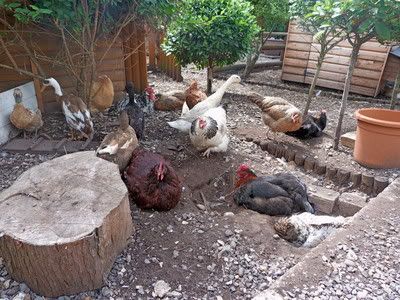
Re: August 2011
Posted: Mon Aug 08, 2011 8:12 pm
by RobS
im looking forward to seeing my first painted lady.you were very lucky.well done with the photos!!
Re: August 2011
Posted: Tue Aug 09, 2011 7:49 pm
by millerd
Took advantage of a slightly early escape from work to go down to Dawney's Hill, Pirbright (near Woking) again.
I only saw three different species: Gatekeepers, Meadow Browns, and (outnumbering them all considerably) Graylings. I walked round the whole area and counted 30 - 40 on the circuit over about an hour between 1645 and 1745. I encountered a dogwalker who seemed to know about the butterflies, and who described to me the abundance of Silver-studded Blues earlier in the year (a sight I missed, sadly).
Among those seen were two mating pairs. The first couple were both in good condition, and the photos bring out the fact that the female was nearly twice the size of the male. I did notice how large some of those flying seemed to be, though many (I presume the the males) were more in the Meadow Brown league. One of these crept unintentionally into shot at one point.
I followed the second pair from the start of their courtship, and there was a curious twist. I watched a male disturb a female, and the pair of them took to the air in a close spiral, rising to about 8 metres before returning to about a metre or so from the ground, where the male then chased the female in an undulating flight reminiscent of Siver-washed Fritillaries. They travelled between the gaps in the gorse, over the heather, and then plummetted to the ground in a sheltered spot. Here, both of them opened and closed their wings for half a minute or so before taking to the air in a repetition of the whole thing. I managed to get some video of one of these interludes, and at the end they were disturbed by a second male. The three of them set off on some energetic flying and eventually one of them gave up. The successful suitor managed to ground the female again, and this time made short work of the foreplay, mating within a minute. It turned out that the successful male was in fact the challenger in the contest, not the original male. The video shows a male in good condition courting the female - my photo shows a scruffy old chap with wings in tatters finally mating with her.
The moral of the story is there's hope for all of us!
If anyone still wants to see Grayling this year, there are still plenty at this site at the moment.
Dave
(Apologies, but I have no way to show the video - which is pity because it shows off the lovely colours of the upperside of this splendid butterfly)












